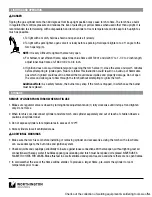
LIGHTING AND OPERATION
DANGER
Tipping the gas cylinder more than 60 degrees from its upright position may cause torch to flare. The torch has a built-
in regulator that controls pressure and reduces the risk of pulsating or yellow flames when used other than upright. It is
recommended to start working with a disposable hand torch cylinder at room temperature and to keep torch upright as
much as possible.
1. To light with a match, hold as shown and open valve (1) slowly.
2. To light with spark lighter, open valve (1) slowly before sparking. Hold spark lighter at a 45° angle to the
torch opening (3).
NOTE:
It is very difficult to light with valve fully open.
3. For hottest, most efficient flame, adjust inner blue flame of WT2201 and UL2317 to 1-1/2 to 2 inch length;
adjust inner blue flame of JT680 to1/2 to 3/4 inch.
4. If ignition does not occur immediately upon opening the torch valve (1), close the valve and wait 5 minutes
before attempting to ignite again. Failure to follow this instruction could result in a build up of flammable
gas which if ignited could result in a fireball that could cause injuries and property damage. Do not open
the valve and allow gas to flow through the torch without attempting to ignite the torch.
Additional Note:
As a safety feature, the burner may snap if the torch is dropped, in which case the burner
must be replaced.
STORAGE
REMOVE CYLINDER FROM TORCH WHEN NOT IN USE
1. Make sure regulator valve is closed by turning flame adjustment knob (1) fully clockwise until it stops. Hand tighten
only. Do not force.
2. When torch is cool, disconnect cylinder and store torch and cylinder separately and out of reach of children.Observe
cautions on cylinder label.
3. Do not expose cylinders to temperatures in excess of 120ºF.
4. Store cylinders in well ventilated areas.
ADDITIONAL WARNINGS
• Make sure the torch is cool before installing or removing cylinder and accessories. Using the torch with a low flame
can cause damage to the burn tube and ignition system.
• Check all joints and couplings periodically to insure against loose connections. With valve open, without lighting, test all
connections with soapy water. If bubbles appear, gas is leaking and torch must be repaired or replaced. NEVER USE A
FLAME TO CHECK FOR LEAKS. Make this test in a well ventilated and spark-free area and where there are no open flames.
• In cold weather the size of the flame will be smaller. To produce a larger flame, pre-warm the cylinder to room
temperature prior to use.
Check out the collection of welding equipment & soldering tools we offer.



